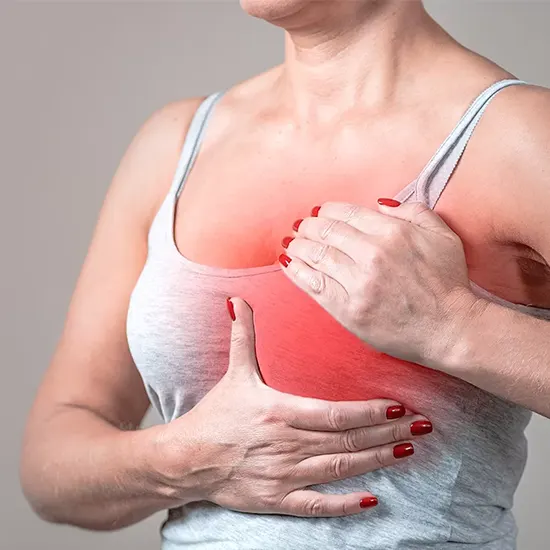
Breast cancer is a type of cancer that occurs in one or both breasts when cells in the breast tissue begin to grow uncontrollably. It is the most common cancer among women worldwide but some male also gets it. Various risk...
Breast cancer is a type of cancer that occurs in one or both breasts when cells in the breast tissue begin to grow uncontrollably. It is the most common cancer among women worldwide but some male also gets it. Various risk factors increase the female’s likelihood of developing breast cancer. The risk factors can be family history, genetic mutation, exposure to radiation, alcohol consumption, etc. It can be prevented with early diagnosis, and the right preventive measures at right time.
About Breast Cancer
Breast cancer is a type of cancer that starts in the breast tissue cells. Being the leading cancer among female over the globe, It is common not only among the female in India but worldwide. Men also can develop this cancer type. It can be caused by a combination of genetic, environmental as well as hormonal factors. Research says that in 2022, In Indian women breast cancer account for about 14% of all cancers.
Types of Breast Cancer
There are several common types of breast cancer, including
- Ductal carcinoma in situ
- Infiltrating (invasive) ductal carcinoma
- Invasive lobular carcinoma
- Inflammatory breast cancer
Other types of breast cancer, including
- Lobular carcinoma in situ
- Male Breast Cancer
- Paget’s disease of the breast
- Tripple Negative Breast Cancer
Ductal carcinoma in situ: This is a non-invasive type of cancer that starts in the milk ducts of your breast. It is an easily treatable type with prompt care and preventive measures.
Infiltrating (invasive) ductal carcinoma (IDC): It is the most common type accounting for 80% of all cases. It starts from the milk duct and spread to other parts if left untreated.
Invasive lobular carcinoma(ILC): This type of cancer starts in the milk production glands( lobules) in the breast and can spread to other parts of the body.
Inflammatory breast cancer (IBC): This is a rare but aggressive kind of breast cancer that causes the breasts to be red, inflamed, swollen and tender, etc.
Stages of Breast Cancer
Breast cancer is typically staged based on the size and extent of the tumor, as well as whether it has spread to nearby other body organs or lymph nodes. Breast cancer staging is important for the most appropriate treatment options for an individual. The earlier stage of breast cancer, the better chances of successful treatment and survival. Regular breast self-exams and mammograms are important for the early detection of breast cancer, especially for women over 40 or those with a family history of breast cancer.
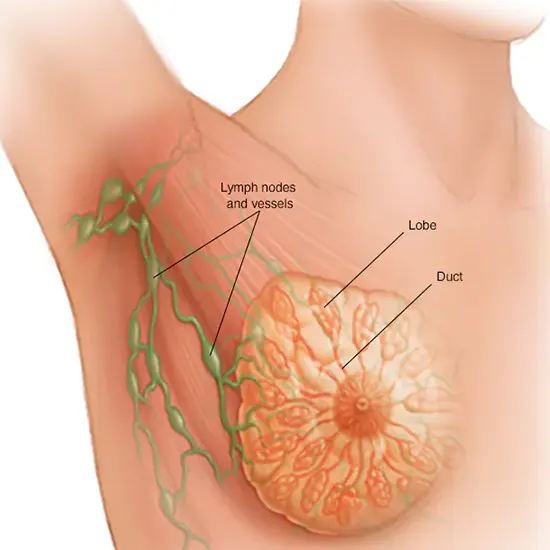
The stages of breast cancer are:
- Stage 0
- Stage 1
- Stage 2
- Stage 3
- Stage 4
Stage 0 (carcinoma in situ): This is a non-invasive type of breast cancer starts in the milk ducts or lobules of the breast and has not spread to nearby tissues.
Stage I: The tumor at this stage is small and has not spread to other parts of the body and nearby Lymph nodes.
Stage II: At this stage, the tumor is larger, between 2cms and 5cms, and may or may not have spread to nearby lymph nodes, or the tumor is smaller but has spread to nearby lymph nodes.
Stage III: At this stage, the tumor is larger, it is greater than 5cms and has spread to nearby lymph nodes, or it has spread to nearby tissues or organs, such as the chest wall or skin.
Stage IV (Metastatic Breast Cancer): Cancer has spread to other body parts (bones, liver, lungs etc.)
Symptoms of Breast Cancer
Cancer of the breast may not always cause symptoms, especially in the early stages of cancer. However, some common signs/ symptoms of breast cancer may include:
- A lump or thickening in the breast
- A lump or thickness in the underarm area.
- Changes in the size of the breast
- Changes in the shape of the breast
- Nipple discharge.
- Nipple inversion.
- Change in the skin of the breast
- Breast pain
- Breast tenderness.
- Swelling in the armpit
- Lump in the armpit.
- A rash around one of the nipples.
- A rash on the nipples
Many of these symptoms can also be caused by other conditions, so they don't necessarily mean that a person has breast cancer. However, if any of these symptoms persist or are unusual for the person, it's important to consult a healthcare professional for further evaluation.
Causes of Breast Cancer
Research says that breast cancer is caused by a combination of a variety of genetic, hormonal, and environmental factors. Having one or more of the causes doesn’t mean that females will develop cancer of the breast, even some females without any of the causes or risk factors may still develop cancer of the breast. Therefore, regular self-exams and mammograms are important for the early
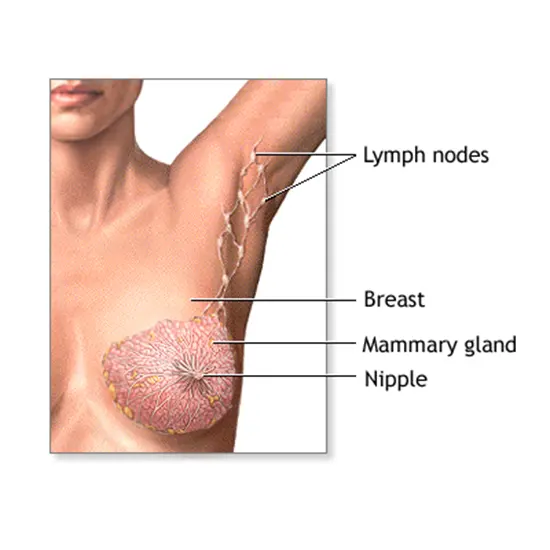
Detection of breast cancer, especially for women over 40 or those with a family history of breast cancer.
Some of the factors that can increase a female's risk of developing breast cancer include:
Age: As female get older the breast cancer risk increases. It usually diagnosed in female of age group of 50 or more.
Family history: Female with a family history of cancer of breast in a first-degree relative (mother, sister).
Genetic mutations: Inherited mutations(changes) in the BRCA1 or BRCA2 genes.
Hormonal factors: Exposure to estrogen and progesterone, especially over a long period
Alcohol consumption: Drinking alcohol, especially in excess, can increase the risk of breast cancer.
Radiation exposure: Exposure to radiation, especially during puberty or young adulthood can increase the risk of breast cancer.
Benefits of Early Detection of Breast Cancer
The early detection of breast cancer can provide several benefits, such as:
Higher chance of successful treatment: The earlier cancer of breast is detected, the more likely it is to be prevented or treated successfully. When the cancer is caught at an early stage, the treatment is often less extensive and has fewer side effects.
Better rate of survival: Female with early detected breast cancer has a higher chance of survival than female with advanced stage of cancer disease.
Less aggressive treatment: Early detection of the breast cancer always helps in getting less aggressive treatments like lumpectomy (removal of the tumor), chemotherapy and radiation therapy, instead of mastectomy (removal of the entire breast).
Reduced cost of treatment: Initial level of detection of breast cancer may result in reduced cost (less expensive) treatment than treatment at an advanced level.
Improved quality of life: Early detection and treatment can help women avoid or minimize the physical, emotional, and psychological effects of more advanced stages of breast cancer.
Peace of mind: Early detection of cancer of breast can provide women with peace of mind that they have taken proactive steps to maintain their health.
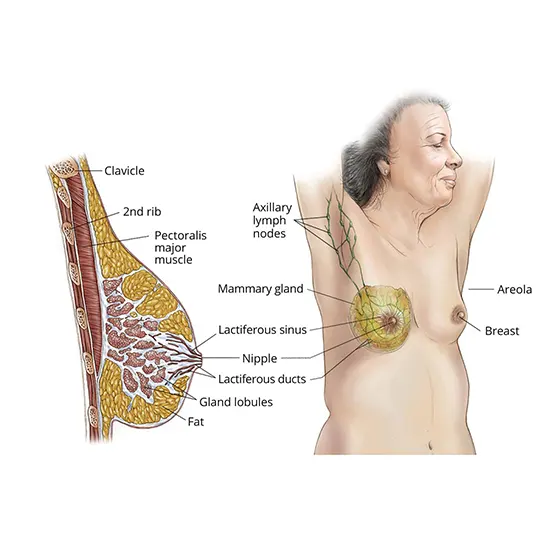
Overall, early detection of breast cancer is crucial for improving treatment outcomes, reducing the need for more aggressive treatments, and enhancing quality of life. Regular breast self-exams and mammograms are important for early detection of breast cancer, especially for women over 40 or those with a family history of breast cancer.
Diagnosis of Breast Cancer
Diagnosis of cancer of breast cancer can be done using various diagnostic methodologies:
Clinical breast examination: Doctor performs a physical examination of the affected breast and surrounding tissues to look for any lumps, bumps, or changes in shape or texture.
Mammogram: Mammogram is an x-ray of the breast tissue that can detect small size tumors or other abnormalities that are not noticeable during a physical examination of the breast.
Breast ultrasound: Ultrasound of breast is a non-invasive imaging test that uses the sound waves to create images of the breast tissue and can help distinguish between solid tumors and fluid-filled cysts.
Breast MRI: MRI of breast is a non-invasive imaging test that uses magnetic fields and radio waves to produce the detailed images of the breast tissues.
Biopsy: It is an invasive procedure to remove the sample of breast tissues from the breasts for examination under a microscope. It can be done using the fine needle aspiration or by removal of breast tissues surgically
Genetic testing: Blood or saliva tests to determine if a person has genetic mutations in the BRCA1 or BRCA2 genes that increase their risk of developing breast cancer.
Whole Body PET Scan: The whole body pet scan is an imaging procedure that is used to identify the area of cancer spread that may not shown by the MRI scan. This scanning procedure find out the potential breast cancer spread.
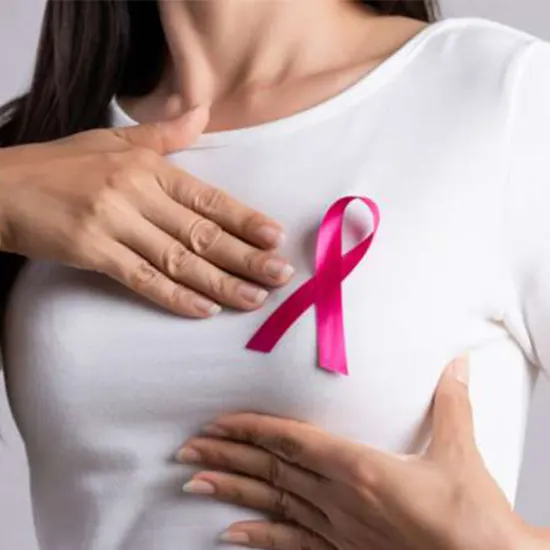
Conclusion
Early detection of breast cancer is crucial for the successful treatment of breast cancer. Regular breast physical examination and other diagnostic procedure can help detect breast cancer in its early stages when it is most treatable. Treatment options for breast cancer totally depend on the type and stage of breast cancer, as well as other factors such as the person's overall health and preferences.
Ganesh Diagnostic offers an ideal preventive breast cancer check-up package to determine if cancer is present or not. For more information, you can talk to our team of health counsellor 24*7.















